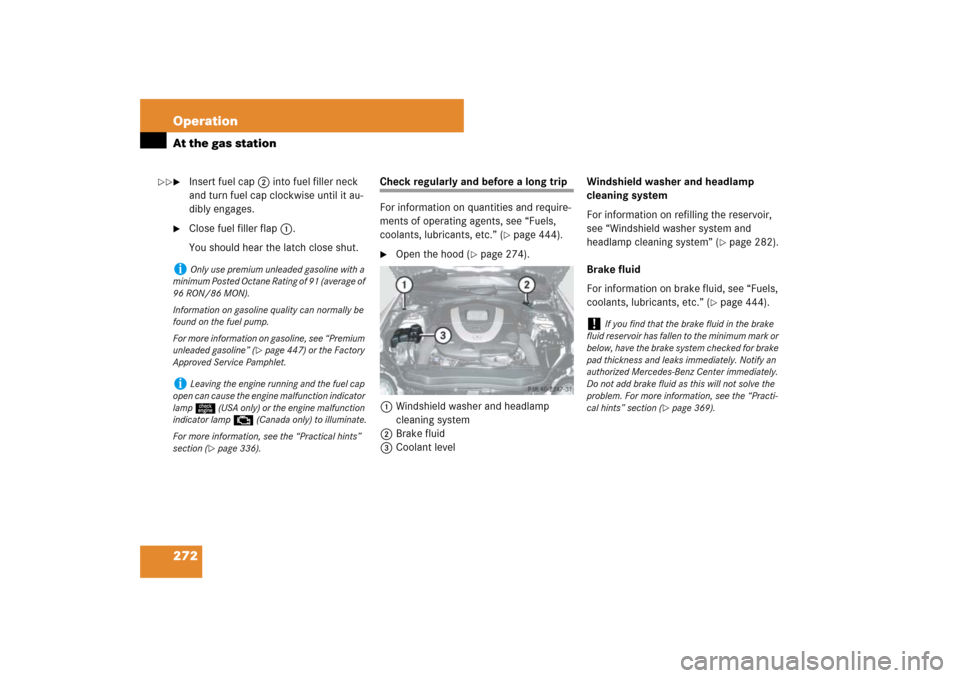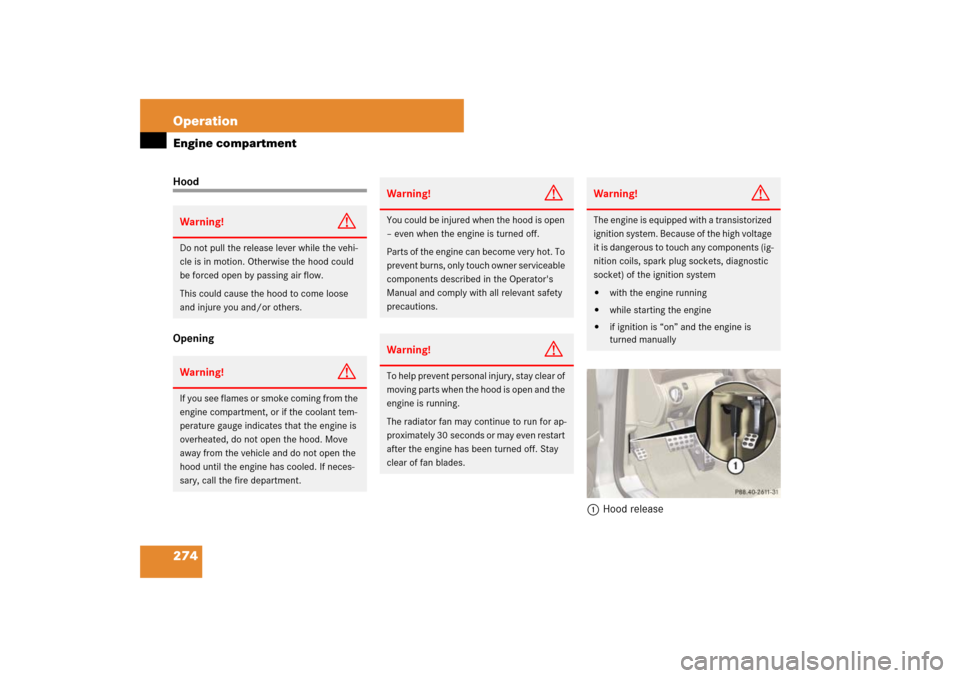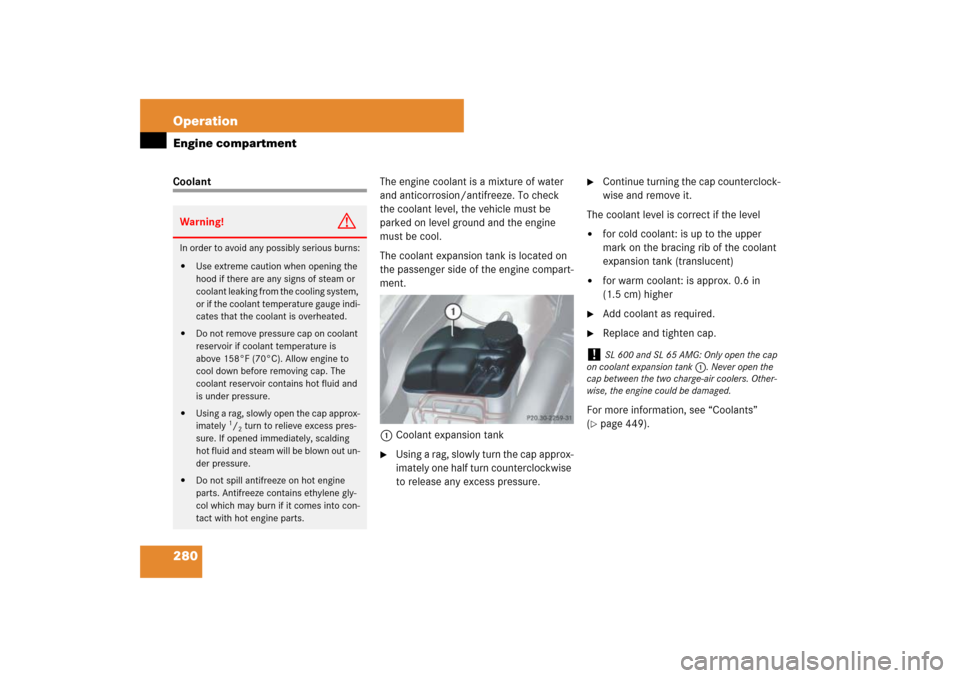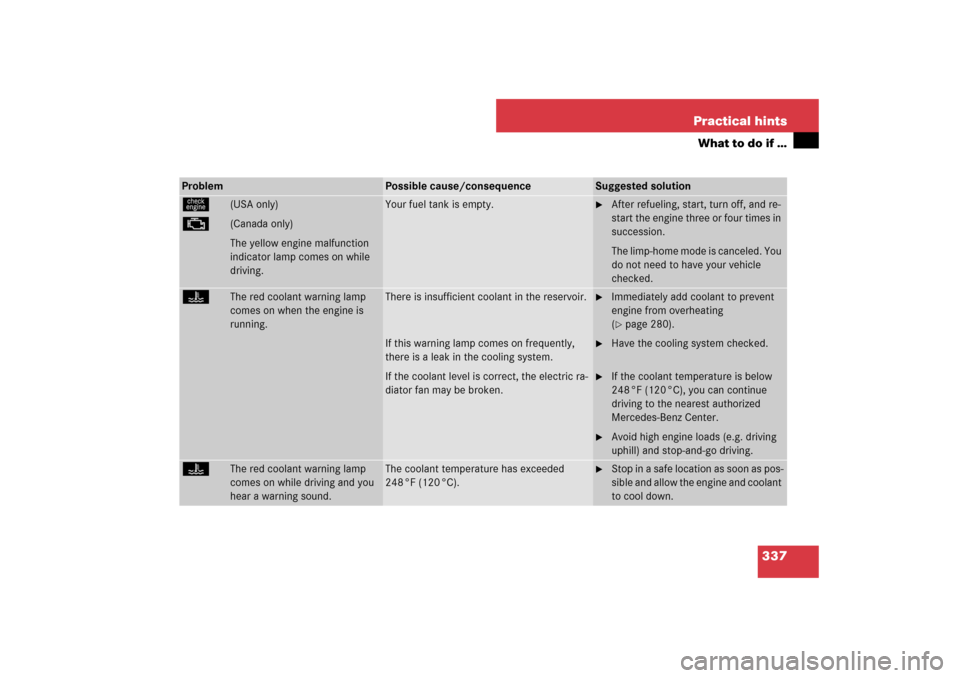Page 273 of 473

272 OperationAt the gas station�
Insert fuel cap 2 into fuel filler neck
and turn fuel cap clockwise until it au-
dibly engages.
�
Close fuel filler flap 1.
You should hear the latch close shut.
Check regularly and before a long trip
For information on quantities and require-
ments of operating agents, see “Fuels,
coolants, lubricants, etc.” (
�page 444).
�
Open the hood (
�page 274).
1Windshield washer and headlamp
cleaning system
2Brake fluid
3Coolant levelWindshield washer and headlamp
cleaning system
For information on refilling the reservoir,
see “Windshield washer system and
headlamp cleaning system” (
�page 282).
Brake fluid
For information on brake fluid, see “Fuels,
coolants, lubricants, etc.” (
�page 444).
i
Only use premium unleaded gasoline with a
minimum Posted Octane Rating of 91 (average of
96 RON/86 MON).
Information on gasoline quality can normally be
found on the fuel pump.
For more information on gasoline, see “Premium
unleaded gasoline” (
�page 447) or the Factory
Approved Service Pamphlet.
i
Leaving the engine running and the fuel cap
open can cause the engine malfunction indicator
lamp ú (USA only) or the engine malfunction
indicator lamp ± (Canada only) to illuminate.
For more information, see the “Practical hints”
section (
�page 336).
!
If you find that the brake fluid in the brake
fluid reservoir has fallen to the minimum mark or
below, have the brake system checked for brake
pad thickness and leaks immediately. Notify an
authorized Mercedes-Benz Center immediately.
Do not add brake fluid as this will not solve the
problem. For more information, see the “Practi-
cal hints” section (
�page 369).
��
Page 274 of 473
273 Operation
At the gas station
Coolant level
For information on checking the coolant
level, see “Coolant” (
�page 280).
Engine oil level
For more information on checking the en-
gine oil level, see “Engine oil”
(
�page 275).
Vehicle lighting
Check function and cleanliness. For more
information, see “Replacing bulbs”
(�page 397).
Exterior lamp switch, see “Switching on
headlamps” (
�page 55).
Tire inflation pressure
For information on checking the tire infla-
tion pressure, see “Checking tire inflation
pressure” (
�page 292).
Page 275 of 473

274 OperationEngine compartmentHood
Opening
1Hood releaseWarning!
G
Do not pull the release lever while the vehi-
cle is in motion. Otherwise the hood could
be forced open by passing air flow.
This could cause the hood to come loose
and injure you and/or others.Warning!
G
If you see flames or smoke coming from the
engine compartment, or if the coolant tem-
perature gauge indicates that the engine is
overheated, do not open the hood. Move
away from the vehicle and do not open the
hood until the engine has cooled. If neces-
sary, call the fire department.
Warning!
G
You could be injured when the hood is open
– even when the engine is turned off.
Parts of the engine can become very hot. To
prevent burns, only touch owner serviceable
components described in the Operator's
Manual and comply with all relevant safety
precautions.Warning!
G
To help prevent personal injury, stay clear of
moving parts when the hood is open and the
engine is running.
The radiator fan may continue to run for ap-
proximately 30 seconds or may even restart
after the engine has been turned off. Stay
clear of fan blades.
Warning!
G
The engine is equipped with a transistorized
ignition system. Because of the high voltage
it is dangerous to touch any components (ig-
nition coils, spark plug sockets, diagnostic
socket) of the ignition system�
with the engine running
�
while starting the engine
�
if ignition is “on” and the engine is
turned manually
Page 281 of 473

280 OperationEngine compartmentCoolantThe engine coolant is a mixture of water
and anticorrosion/antifreeze. To check
the coolant level, the vehicle must be
parked on level ground and the engine
must be cool.
The coolant expansion tank is located on
the passenger side of the engine compart-
ment.
1Coolant expansion tank
�
Using a rag, slowly turn the cap approx-
imately one half turn counterclockwise
to release any excess pressure.
�
Continue turning the cap counterclock-
wise and remove it.
The coolant level is correct if the level
�
for cold coolant: is up to the upper
mark on the bracing rib of the coolant
expansion tank (translucent)
�
for warm coolant: is approx. 0.6 in
(1.5 cm) higher
�
Add coolant as required.
�
Replace and tighten cap.
For more information, see “Coolants”
(
�page 449).
Warning!
G
In order to avoid any possibly serious burns:�
Use extreme caution when opening the
hood if there are any signs of steam or
coolant leaking from the cooling system,
or if the coolant temperature gauge indi-
cates that the coolant is overheated.
�
Do not remove pressure cap on coolant
reservoir if coolant temperature is
above 158°F (70°C). Allow engine to
cool down before removing cap. The
coolant reservoir contains hot fluid and
is under pressure.
�
Using a rag, slowly open the cap approx-
imately
1/2 turn to relieve excess pres-
sure. If opened immediately, scalding
hot fluid and steam will be blown out un-
der pressure.
�
Do not spill antifreeze on hot engine
parts. Antifreeze contains ethylene gly-
col which may burn if it comes into con-
tact with hot engine parts.
!
SL 600 and SL 65 AMG: Only open the cap
on coolant expansion tank1. Never open the
cap between the two charge-air coolers. Other-
wise, the engine could be damaged.
Page 338 of 473

337 Practical hints
What to do if …
Problem
Possible cause/consequence
Suggested solution
ú
(USA only)
±
(Canada only)
The yellow engine malfunction
indicator lamp comes on while
driving.
Your fuel tank is empty.
�
After refueling, start, turn off, and re-
start the engine three or four times in
succession.
The limp-home mode is canceled. You
do not need to have your vehicle
checked.
D
The red coolant warning lamp
comes on when the engine is
running.
There is insufficient coolant in the reservoir.
If this warning lamp comes on frequently,
there is a leak in the cooling system.
If the coolant level is correct, the electric ra-
diator fan may be broken.
�
Immediately add coolant to prevent
engine from overheating
(�page 280).
�
Have the cooling system checked.
�
If the coolant temperature is below
248 °F (120 °C), you can continue
driving to the nearest authorized
Mercedes-Benz Center.
�
Avoid high engine loads (e.g. driving
uphill) and stop-and-go driving.
D
The red coolant warning lamp
comes on while driving and you
hear a warning sound.
The coolant temperature has exceeded
248 °F (120 °C).
�
Stop in a safe location as soon as pos-
sible and allow the engine and coolant
to cool down.
Page 339 of 473
338 Practical hintsWhat to do if …
During severe operating conditions, e.g.
stop-and-go traffic, the coolant tempera-
ture may rise close to 248°F (120°C).
Warning!
G
Driving when your engine is overheated can
cause some fluids which may have leaked
into the engine compartment to catch fire.
You could be seriously burned.
Steam from an overheated engine can cause
serious burns and can occur just by opening
the engine hood. Stay away from the engine
if you see or hear steam coming from it.
Turn off the engine, get out of the vehicle
and do not stand near the vehicle until the
engine has cooled down.
!
The engine should not be operated with the
coolant temperature above 248°F (120°C). Do-
ing so may cause serious engine damage which
is not covered by the Mercedes-Benz Limited
Warranty.
Page 372 of 473
371 Practical hints
What to do if …
Left display
Right display
Possible cause/consequence
Possible solution
•
Coolant
Stop car –
Turn engine off
The coolant is too hot.
Among other possible causes, the
poly-V-belt could be broken.
�
Stop the vehicle in a safe location or as soon
as it is safe to do so.
�
Turn off the engine.
�
Check the poly-V-belt.
If it is broken:
�
Do not continue to drive. Otherwise, the en-
gine will overheat due to an inoperative water
pump which may result in damage to the en-
gine. Contact an authorized Mercedes-Benz
Center.
If it is intact:
�
Wait for the message to disappear before re-
starting the engine.
Doing otherwise could result in serious engine
damage that is not covered by the
Mercedes-Benz Limited Warranty.
(Continued on next page)
Page 373 of 473

372 Practical hintsWhat to do if …
During severe operating conditions, e.g.
stop-and-go traffic, the coolant tempera-
ture may rise close to 248°F (120°C).
Left display
Right display
Possible cause/consequence
Possible solution�
Observe the coolant temperature gauge in the
instrument cluster (
�page 27).
If the temperature rises again:
�
Contact an authorized Mercedes-Benz
Center immediately.
Warning!
G
Driving when your engine is overheated can
cause some fluids which may have leaked
into the engine compartment to catch fire.
You could be seriously burned.
Steam from an overheated engine can cause
serious burns and can occur just by opening
the engine hood. Stay away from the engine
if you see or hear steam coming from it.
Turn off the engine, get out of the vehicle
and do not stand near the vehicle until the
engine has cooled down.
!
The engine should not be operated with the
coolant temperature above 248°F (120°C). Do-
ing so may cause serious engine damage which
is not covered by the Mercedes-Benz Limited
Warranty.